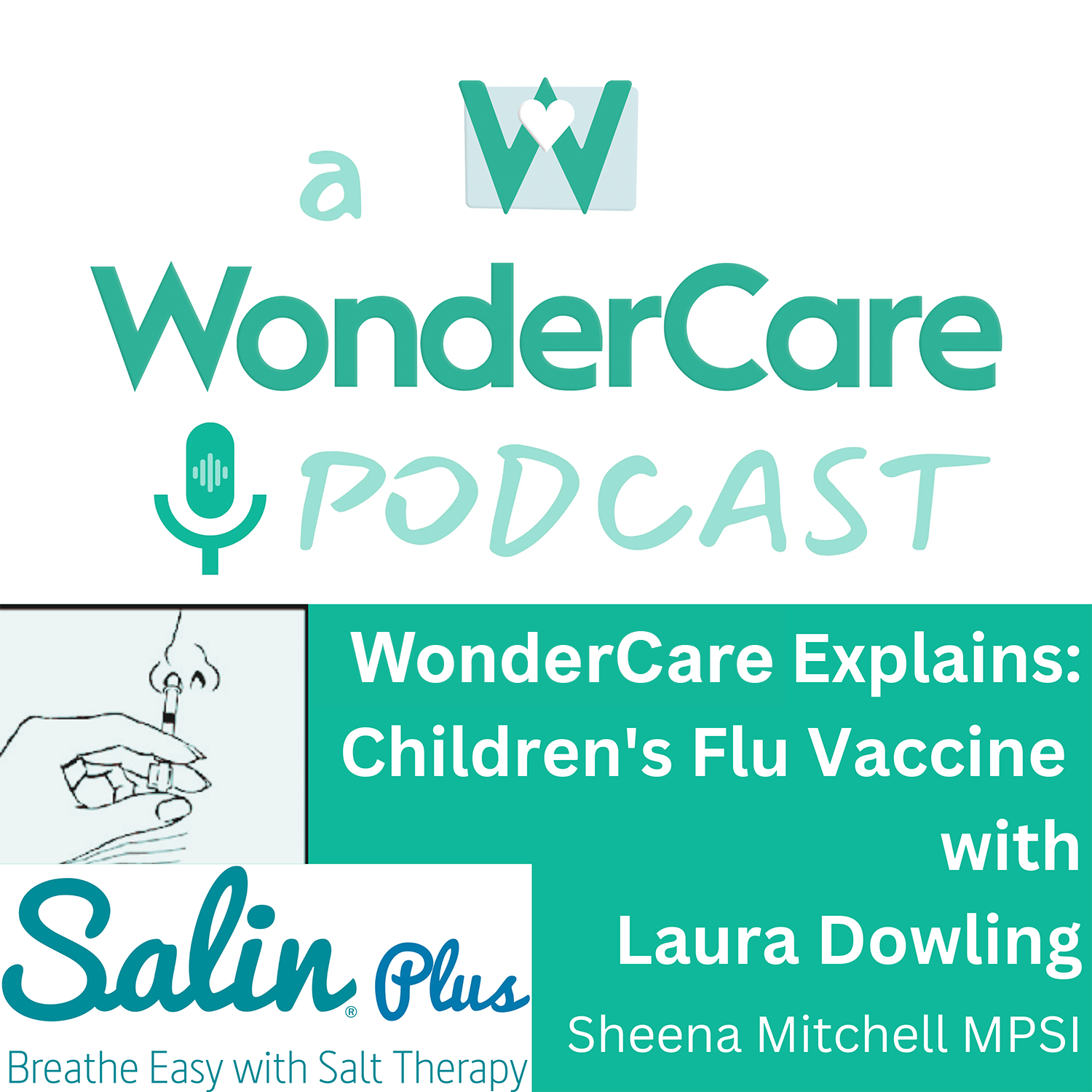Episode Transcript
[00:00:05] Speaker A: Hello and welcome to a Wonder Care podcast. I'm Sheena Mitchell, a pharmacist and mum of three. I combine healthcare and practical advice to support you on your parenting journey.
[00:00:16] Speaker B: Hello everyone, and a very happy new year to you all. I hope you had a much healthier Christmas season than I did. Unfortunately, as you'll have seen on my instagram, I suffered with quite a serious strep a skin condition. And actually, look, it is what it is. I'm immunocompromised. I'm susceptible to these things. That's a story for another day. But it did remind me how important it was to talk about Strep A, particularly this year. Unless you've been living under a rock, it's very clear that the levels of rsv have been so incredibly high, and flu is now seriously on the rise. And you might ask yourself, why does this matter in terms of strep A? It has been scientifically proven that a recent influenza infection increases your risk of contracting strep A. And this includes the invasive group a streptococcal disease, the most common kind of eye gas. This invasive group a strep is something called streptococcal toxic shock syndrome, stss. Now, it's rare, but it's basically when a strep a infection gets into your deep tissues and your bloodstream. I wanted to highlight the link between strep A and influenza. There's more research to be done in relation to rsv, whether high levels will really impact it or not, but it is thought that all respiratory viruses increase your risk. Last year we had crazy high levels of rsv and flu as well. And as a likely result of that, data from 2023 shows that the number of Igas cases are 4.3 times higher than expected. So normally pre pandemic, we would hear of a reported approximate 117 cases, whereas last year it was 509. And that was just in the first eleven months. Between the 2 October 22 and the 2 December 23, there were 570 cases of invasive group A strep. Another problem is that normally it would be 25% of cases in children under 18. But last year we saw this percentage grow to 41%. And we do know that it is the younger age groups that are more susceptible to rsv and flu in their severe forms. Among the cases that have been notified since October 22, there's been twelve deaths in children, and ten of these have been under ten years of age. There's been 21 deaths in adults. And as I said on Instagram during the week, like one death is one family absolutely shattered. So it's quite frightening to think about the impact that this has had. Once we got through that early surge, up until August, the numbers of igas kind of went back to normal levels and they continued that way until December. So it was like once all of the main viral illnesses had stopped circulating, things returned to normal. Since early December, there has been a slight increase in eye gas cases. Now, at the moment, it's predominantly in adults, but I just really want to highlight it because I think it's so, so important that we know what to look out for. Obviously, respiratory viruses do not require an antibiotic and antimicrobial resistance is really, really important. But you do need to be able to tell the difference between a strep a infection and a virus. And obviously we can't diagnose ourselves. That's what the doctors are for. So in this episode, I'm just going to go through a little bit of information about strep A and scarlet fever so that you know what to look out for and when to see the doctor, because the main thing is, once you start an antibiotic for strep bay infection, generally you're not contagious after 24 to 48 hours, whereas if you don't treat it, you can be infectious for three weeks. So that's another important thing to be aware of. I myself had, I'm going to call the privilege of using antibiotics, which started on the 19th, 20 December, my birthday, when I did develop that ericipolis type cellulitis condition on my face. And it was extremely close to my eye and my GP was very concerned because obviously it's right beside my eye, my eye is right beside my brain and all of a sudden you're talking huge sepsis risk. And it is possible that if the antibiotics had not worked for me, that it could have been a very different outcome. And I suppose that's why I'm so passionate about the importance of preventing antimicrobial resistance. We need to conserve antibiotics and we need to use them wisely and correctly so that they do work when we need them. Before we had antibiotics, people just died from bad infections. These are life saving medications and we need to make sure that they will continue to be for our children and their kids. Anyway, I hope you find this episode informative. So let's get started.
[00:05:53] Speaker C: Group A, strep infection can be a secondary infection, which happens as a result of a viral infection and invasive. Group A strep is when it becomes a serious infection. So what is group A? Strep group A streptococcus is a common bacteria. Lots of us carry it in our throats and on our skin, and it doesn't always result in illness, but it can be responsible for some mild and some more serious infections. When it becomes more serious, it's known as invasive group a strep. This happens when the bacteria from the milder infection gets into parts of the body where it wouldn't normally be, such as the lungs or the bloodstream. It is this form of group A strep, the invasive form that can be fatal.
I just want to take a little.
[00:06:39] Speaker A: Break for a second to say that I'm delighted to partner again with one of my all time favorite products, salon plus this is the world's 1st 100% natural dry salt therapy device. It's clinically proven to relieve a wide range of allergens and respiratory conditions. The salt therapy method has been trusted for generations and is now hugely popular worldwide. As more and more people recognize the superb results achieved from a natural and noninvasive method, this device will help you breathe easier and sleep better.
[00:07:13] Speaker C: A normal group a strep infection can cause illness in the form of scarlet fever, a sore throat, or even impetigo. I think it's a good idea to just be aware of the symptoms of invasive group a strep. So if your child has gone through a period of being unwell, you can monitor their symptoms and keep an eye out for the following so that you know when you need to seek medical attention to ensure that if your child's group a strep has become invasive, that you can get the help that you need. These symptoms include a very high fever with severe muscle aches, if they get a lot of redness or blisters at the site of a wound. Because remember, strep can access the skin through the opening in the wound, and it can access the blood supply that way. And obviously, with children having maybe chickenpox, there is a potential for a lot of scratching and a lot of little wounds being around, and I suppose a pathway for infection to access the body. So you're always going to look at each and every spot when your child has something like chickenpox, or even if they just fall and get a cut, and you're going to keep an eye to make sure that it's not getting very red, very swollen, there isn't a lot of heat around it. These are the things that you're looking out for. Other symptoms of invasive group a strep include localized muscle tenderness. So if your child or yourself or an adult or an older adult are complaining of tenderness in one area of muscle. Also, low blood pressure and dizziness. This can be identifiable when you stand up in the morning if you feel very dizzy, or throughout the day, especially going from sitting to rising. If you've come very dizzy, it is possible that your blood pressure is low. A patient with invasive group a strep can also become very confused. They can be complaining of stomach pain, and they can also suffer from nausea and vomiting. As I said there, group a strep can be the cause of many normal illnesses, such as tonsillitis, impetigo, cellulitis, and it also is responsible for scarlet fever.
If your child is feeling very unwell with kind of flulike symptoms, and if you're worried that it might be scarlet fever, easy ways to identify scarlet fever are, first of all, having a little look at their tongue. At the beginning, it can be red and tender, a bit swollen, and then it can go on to get a white coating which may peel off. And they'll also have maybe swollen neck glands, a sore throat, a headache, and one of the more distinctive features is the rash. So a scarlet fever rash appears a day or two after the other symptoms, and it generally starts with red blotches that turn into a characteristic pink red rash, which feels like sandpaper. Some people think it looks like sunburn, but when you feel it, it is quite rough. It normally starts on the chest and back and spreads to other areas, like the legs, arms and groin. It doesn't usually spread to the face, but what happens on the face is that your cheeks can become quite flushed. The rash with scarlet fever lasts around one week. If you notice this rash, or the swollen tongue and your child is feeling unwell, it's important to note that antibiotics are recommended for the treatment of scarlet fever, so you will need to go.
[00:10:42] Speaker A: To the GP in that case.
[00:10:44] Speaker C: Other situations that you might need to go to the GP if your child is unwell is basically anytime that they're getting dramatically and rapidly worse. If you're sitting with your child and you notice over a couple of hours that your child is just deteriorating quite rapidly, it's always important to go and seek medical attention in that situation. Also, because group a strep infections can cause a lot of conditions that present with sore throat, like tonsillitis, you do need to watch out for signs of dehydration. So if your child is in nappies and they haven't had a wet nappy for more than 12 hours, or if they're not taking at least half of their normal levels of fluids, then you should see the doctor. Also, if you've got a baby under three months and their temperature is over 38 degrees, you need to see the doctor. And the same if they're older than three months and their temperature is 39 degrees or higher, because there's also viral meningitis doing the rounds, it is important to say that if your child has a rash that doesn't fade when you press a glass on it, you should go to an emergency department. And also, if your child has any difficulty breathing or their skin is very pale, cold or clammy, and they have a little bit of blueness around their tongue or lips, these are all situations that you really need to go to an emergency department.
What can we do to help reduce the risk of infection when invasive group based strep cases are high? Really, it's back to the good old hand hygiene and respiratory hygiene. So ensure to teach your child to keep wash, wash, washing those hands, and to keep up good cough and sneezing etiquette, like using a tissue to catch coughs. And it's also important to just be aware of what's going on so that if your child is unwell, you really do need to keep them out of childcare or school. And that just helps to stop infection spreading and hopefully reduce the number of cases of invasive group a strep. Something that you might find useful to know is that we stock the strep a home test. It's available on our website, Wondercare ie, and the name of the product is Wandfo. So if you search Wandfo, so that's wondfo and it's the strep a test. And you just swab the throat and it will let you know if strep A is present. This can be a helpful little test for reassurance, but obviously, all of the same doctor referral requirements stand in place. Invasive group A strep really does need medical attention. And even if your child is being treated for a normal group a strep infection with antibiotics, and if they're not getting better after a couple of days of being on the antibiotics, it's important to go back to the doctor and let them know that because untreated or under treated can lead to severe complications, including blood poisoning, toxic shock syndrome and damage to the kidneys. This episode hasn't been made to frighten you, but I just think it's really important to be aware. By being aware, we can be more vigilant and hopefully we can ensure that any patients affected have better outcomes because they are more knowledgeable and are quicker to respond to symptoms as they see them happen. I really hope that you found this episode helpful. If you did and you're enjoying a wonder Care podcast, it would be a huge help to me if you could follow and subscribe to the show. Also, if you could leave a review on Spotify, there's a little option at the top where you can select a number of stars. Or over on Apple Podcasts, you can leave a written review that really helps to make the streaming platforms more aware of the podcast, and it means they'll show it to more people when they're searching for health and parenting information accessible health care is a huge priority of mine. Thank you.


